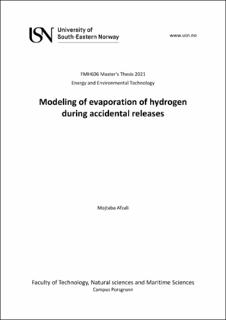| dc.description.abstract | Hopefully, in the near future, liquid hydrogen will be commonly utilized as energy. The cleanest fuel that the primary limit of producing and using it, is safety issues. High possibility safety issues are generated by large amounts of hydrogen, usually stored and transported in the liquid phase. The first phase in developing many accident cycles that end to a significant hazard (e.g., from fire, explosion, and toxic effects) is the discharge of hazardous cryogenic liquids from its container and its evaporation (e.g., liquid hydrogen release), leading to producing dangerous vapor. The main objective of this study is to model this evaporation from the release of liquid hydrogen. The evaporation model is a function of the radius of the spreading pool on the surface. Thus, for modeling the evaporation, the spreading pool on the surface should also be modeled.
Different integral models have been utilized for simulating the spread and vaporization of liquid hydrogen pool, namely Briscoe and Shaw’s (B&S), Constant Froude Number (CFN), and a simplified model of Gas Accumulation over Spreading Pool (GASP). The simplified GASP model is suitable for indoor spills, but since the dominant heat transfer in ambient is heat flux by conduction from the ground, this model is also used to model the evaporation of liquid hydrogen for outdoor releases.
For using spreading and evaporation models, basic knowledge about heat transfer and boiling regimes is required. The boiling regime of hydrogen is essential to determine and specify in detail. Knowledge about the characteristics of heat transfer of hydrogen pool boiling alongside assembling consistent correlations to monitor the boiling heat transfer analysis is essential to the utilization of liquid hydrogen (LH2). Some correlations seeking at various boiling regimes are assessed or adjusted in order to understand the mathematical assessment of hydrogen boiling heat transfer. Several developed correlations for nucleate boiling, critical heat flux (CHF), and minimum heat flux (MHF) suggested by different works are investigated. Comprehensive correlations for hydrogen boiling heat transfer are reviewed, and consequently, a predicted hydrogen boiling curve is formed.
The heat flux from the ground to the pool is determined using two boundary conditions (BCs) at the ground surface. One is specified heat flux, and the other one is specified temperature. The first BC results from suggested correlations for boiling heat transfer regimes (BR-BCs) dependent on the temperature difference between the liquid and the ground surface, while the second is constructed on a hypothesis of perfect thermal contact (PTC-BCs) between the liquid and the ground. The PTC-BCs were found to be in better agreement with the experimental results than the BR-BCs by different works. It was recommended that the PTC-BCs must be applied for a spreading pool while the BR-BCs
must be applied for a non-spreading pool. Thus, the PTC-BC is involved in this study for modeling the evaporation of liquid hydrogen.
The B&S and CFN models, which have the same structures in origin, were applied to model the liquid hydrogen’s pool spreading and evaporation in this work. The models were controversial for lower mass flow rates. It was noticed that these models could not be utilized for spills on land. By presenting a minimum edge depth, altering the constant number ε (originally presented Froude number) corresponding to different mass flow rates, and validating against various cryogenic spills, the model demonstrated a roughly accurate result.
The original GASP model could not simulate without a wind speed, and the equations were hard to solve numerically caused by the considerable unpredictability of time scales produced by the many physical phenomena. Thus, a simplified model of the GASP model was probed to model the spreading and evaporation of the liquid hydrogen pool in no wind condition. The ability of the model was extraordinary and effectively justified against the experimental data.
Overall, the GASP model was in superior agreement with experimental data of cryogenic and liquid hydrogen spills than the B&S and CFN models. Although an empirical correlation was suggested determining the Froude number for different mass flowrate releases by this study, more empirical data is required to obtain a more accurate Froude number. So, CFN and B&S models are demanded more investigation. | |
